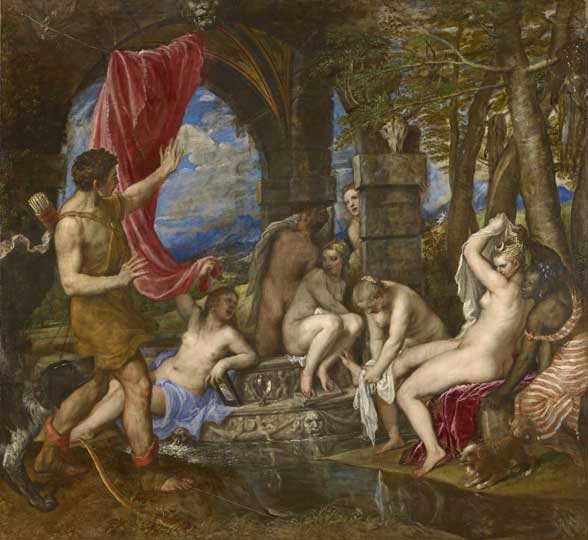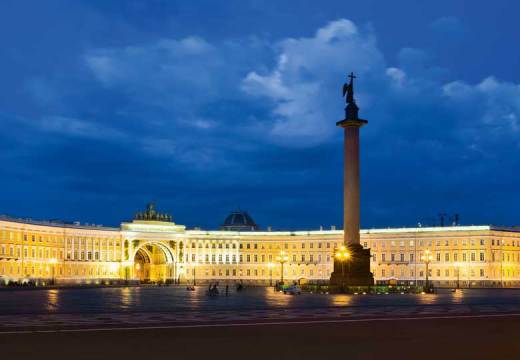How strange it can seem to us that chilly, theocratic Philip II of Spain should have been responsible for commissioning some of the most erotically charged paintings in the western canon. Over a 10-year period from 1552, the king received a series of six large canvases depicting mythological scenes from Ovid’s Metamorphoses painted in Venice by the elderly Titian.
Two of the series, Diana and Actaeon and Diana and Callisto, have been in Britain since their acquisition by the third Duke of Bridgewater in 1798. In the past five years both were bought for the nation from the Duke of Sutherland, and currently form the centrepiece of an exhibition, ‘Titian and the Golden Age of Venetian Art’ at the National Gallery of Scotland (until 14 September).
The show, almost entirely composed of works within the NGS’s own collection occupies two rooms, the first devoted to sacred subjects, the second to profane. Highlights among the former include Lorenzo Lotto’s Virgin and Child of c. 1505 and Jacopo Bassano’s Adoration of the Kings painted almost 40 years later. In both cases attention paid to the subjects’ clothing indicates that even in religious art the material world was never entirely forgotten. The same is also true of Giovanni Cariani’s sumptuous Saint Agatha (1512–17) in which the eponymous virgin is swathed in layers of rich satin from which a hand emerges to rest on a platter bearing two breasts: an indication of how this martyr met her end.
There are many more breasts on display in the second room, not least those on Titian’s Venus Rising from the Sea (1520–25), yet it is rightly the same artist’s two Diana pictures which dominate the entire exhibition. Titian was a septuagenarian by the time he produced the pair and his style was freer than had been the case earlier. The vigour with which he depicts both scenes is astounding, in particular his ability to convey emotional intensity.

Diana and Actaeon (1556–9), Titian
In the Actaeon painting, for example, the viewer is shown not just the young hunter’s dawning awareness of what he has done – and its inevitably fatal consequences – but also the goddess’s mixture of shame and fury that she, no longer in first youth, should have been caught naked and vulnerable. In the second work, it is Callisto, made pregnant by her mistress’s spouse, who feels shame and Diana only anger, again with appalling results. For anyone standing in front of the pictures, however, the dominant emotion is likely to be one of pleasure, not least in details like a nymph’s dainty heel reflected in the water of a stream, or the carved figures around a fountain’s stone basin.
Such aspects help us to appreciate why Philip of Spain, that Most Catholic of Majesties, would have wished to commission these and the rest of the series from Titian. The exhibition encourages reflection on the links, as well as the differences, between sanctified and worldly lives. It is not simply a case of artists moving with ease between one and the other: when Titian sent the two Diana pictures to his patron in Madrid in 1559, he also included an Entombment of Christ (now in the Prado).
Philip’s near contemporary, the mystic St Teresa of Avila famously wrote of a moment of religious ecstasy, ‘The pain was so great that it made me moan; and yet so surpassing was the sweetness of this excessive pain that I could not wish to be rid of it.’ A century later Bernini recreated Teresa’s experience in the Cornaro Chapel, Santa Maria della Vittoria, Rome, his sculpture subsequently permitting the President de Brosses to comment slyly, ‘If this is divine love, then I know it.’ So might we all. The divide between heaven and earth is not so great, and Philip II was wise enough to request that Titian celebrate both.
‘Titian and the Golden Age of Venetian Art’ is at the National Gallery of Scotland until 14 September.
Related Articles
First Look: Titian at the Scottish National Gallery (Aidan Weston-Lewis)














![Masterpiece [Re]discovery 2022. Photo: Ben Fisher Photography, courtesy of Masterpiece London](http://zephr.apollo-magazine.com/wp-content/uploads/2022/07/MPL2022_4263.jpg)
‘Like landscape, his objects seem to breathe’: Gordon Baldwin (1932–2025)